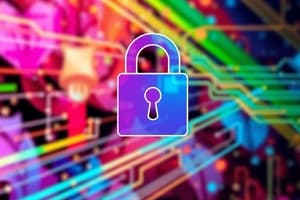Podcast
Questions and Answers
Match the following network and Internet security measures with their descriptions:
Match the following network and Internet security measures with their descriptions:
Access control systems = Regulate who can access what on a network Firewalls = Protect against unauthorized access and filter out potentially harmful incoming and outgoing traffic Encryption = Scramble data so that it becomes unreadable to unauthorized users Phishing = Social engineering attack that attempts to trick individuals into revealing sensitive information
Match the following online theft and identity theft protection measures with their descriptions:
Match the following online theft and identity theft protection measures with their descriptions:
Spoofing = Falsifying data to make it appear as though it is coming from a trusted source Dot cons = Various types of online fraud schemes aimed at deceiving individuals or businesses for financial gain Personal safety risks associated with Internet use = Exposure to cyberbullying, online predators, and harmful or inappropriate content Safeguarding personal safety when using the Internet = Using strong passwords, being cautious about sharing personal information, and avoiding suspicious websites
Match the following examples of unauthorized access and unauthorized use with their descriptions:
Match the following examples of unauthorized access and unauthorized use with their descriptions:
Unauthorized access = Gaining entry to a network, application, data, or device without permission or by using a method not approved by an authorized party Unauthorized use = Using a network, application, data, or device in a way that is not approved by an authorized party
Match the following computer sabotage examples with protective measures:
Match the following computer sabotage examples with protective measures:
Match the following primary concerns about network and Internet security with their explanations:
Match the following primary concerns about network and Internet security with their explanations:
Flashcards are hidden until you start studying




